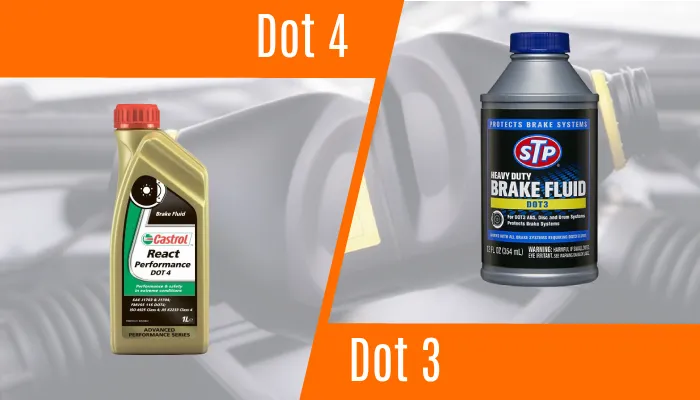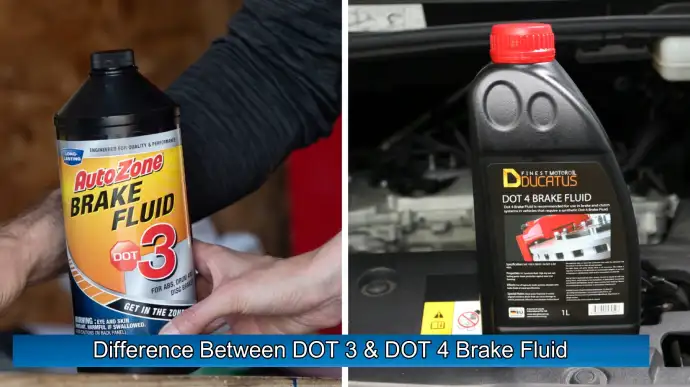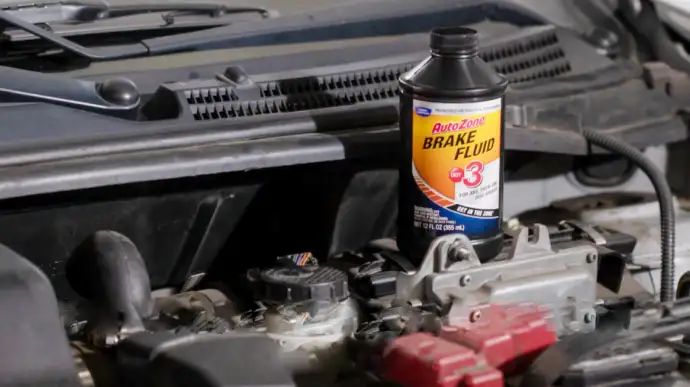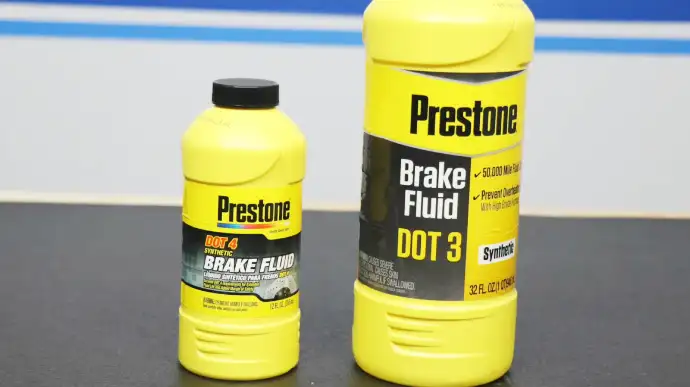Physical Address
304 North Cardinal St.
Dorchester Center, MA 02124
Physical Address
304 North Cardinal St.
Dorchester Center, MA 02124

Brake fluid is a vital component of your vehicle’s braking system. It is responsible for transmitting the force applied to the brake pedal to the brake calipers or wheel cylinders. Two common types of brake fluids used in vehicles are DOT 3 and DOT 4.
DOT 4 has a larger boiling point, around 230°C (446°F), making it ideal for heavy brake applications and high-performance vehicles. In contrast, DOT 3 has a lower boiling point, approximately 205°C (401°F).
The rubber seals and components in older vehicles are more gentle with DOT 3. Conversely, DOT 4’s increased moisture absorption and potentially aggressive nature may cause the components to degrade faster.
Here, we will explore the differences between DOT 3 and DOT 4 brake fluids, including their performance, compatibility, and suitability for various vehicle types. So, let’s dive into the fascinating world of brake fluid.

When comparing Dot 4 and Dot 3 brake fluids, several key differences exist. And most of them are related to their boiling points.
To understand the differences between DOT 4 and DOT 3 brake fluid for your vehicle, consider the additives and compositions of each.
DOT 4 brake fluid contains additional additives, such as borate esters, which enhance its performance characteristics. These additives contribute to DOT 4’s increased boiling points and moisture resistance, making it more suitable for demanding applications.
On the other hand, DOT 3 brake fluid relies solely on its glycol ether base and doesn’t offer the same level of performance in extreme conditions. The glycol-based composition of both fluids provides the hydraulic properties necessary for braking systems.
Still, the presence of borate esters in DOT 4 gives it an advantage in terms of performance and durability.
You should know that DOT 4 brake fluid has higher boiling points and superior heat resistance than DOT 3 brake fluid for your vehicle.
DOT 4 brake fluid has a dry boiling point of around 230°C (446°F), while DOT 3 brake fluid stands at approximately 205°C (401°F). In high-performance vehicles and during heavy braking, DOT 4 brake fluid can withstand extreme heat due to its higher boiling point.
Conversely, DOT 3 brake fluid’s lower boiling point may not hold up as well under intense braking conditions, potentially leading to brake fade. But DOT 3 brake fluid can be just as effective in the right application.
When comparing DOT 3 and DOT 4 brake fluids, it’s also important to consider their compatibility with rubber seals and brake system components.
DOT 3 brake fluid is generally gentler on rubber seals and components, making it a better choice for older vehicles that have these materials.
Then again, the DOT 4 brake fluid has increased moisture absorption and is potentially more aggressive. It may lead to quicker degradation of rubber seals and components.
When considering the hygroscopic properties of DOT 4 and DOT 3 brake fluids, you should note that DOT 4 brake fluid is more moisture-absorbent than DOT 3. This means that DOT 4 brake fluid has a higher tendency to absorb moisture from the air over time.
As a result, it can absorb a greater amount of water compared to DOT 3 brake fluid. The higher moisture absorption capacity of DOT 4 brake fluid allows it to maintain a higher wet boiling point.
However, DOT 3 brake fluid isn’t entirely without its benefits. Since it absorbs less moisture, it remains more stable over time. This means that DOT 3 brake fluids are well-suited for vehicles that don’t experience heavy use or extreme temperatures.
DOT 4 is recommended for high-performance vehicles and those subjected to stop-and-go city driving or larger vehicles like trucks and SUVs. The higher boiling point of DOT 4 fluid makes it more resistant to heat buildup, which is crucial for vehicles that experience frequent and intense braking.
On the other hand, DOT 3 fluid is more suitable for regular passenger vehicles where extreme braking conditions are less common. Its lower boiling point still meets the requirements of most everyday driving situations.
You should consider the ceramic brake pad capability when deciding between DOT 4 and DOT 3 brake fluid for your vehicle. Ceramic brake pads generate higher levels of heat during braking, which can impact the brake fluid’s performance.
DOT 4 brake fluid is recommended for vehicles equipped with ceramic brake pads because it has a higher boiling point than DOT 3. The elevated boiling point of DOT 4 brake fluid allows it to better cope with the increased heat generated by ceramic brake pads.
Consequently, DOT 3 brake fluid may struggle to maintain its performance when used with ceramic brake pads. Sometimes, the boiling point of DOT 3 brake fluid can be too low for some vehicles equipped with ceramic brake pads, leading to reduced braking performance.
DOT 3 brake fluid is generally more cost-effective, making it a popular choice for budget-conscious consumers. It suits most standard vehicles and offers adequate performance for everyday driving conditions.
Alternatively, DOT 4 brake fluid is typically more expensive due to its superior performance characteristics. It has a higher boiling point, making it ideal for high-performance vehicles or those subjected to heavy use.
The elevated heat resistance of DOT 4 ensures optimal brake performance and safety under demanding conditions.
| Characteristic | DOT 3 Brake Fluid | DOT 4 Brake Fluid |
| Composition | Glycol-based with no additional additives | Glycol-based with borate esters and additives for enhanced performance |
| Boiling Point (Dry) | Approx. 205°C (401°F) | Approx. 230°C (446°F) |
| Heat Resistance | Suitable for regular driving conditions | Superior heat resistance, ideal for heavy braking and high-performance vehicles |
| Seal & Component Compatibility | Gentle on rubber seals and components | Rubber seals and components may degrade faster as a result |
| Hygroscopic Properties | Less hygroscopic, absorbs less moisture | More hygroscopic, absorbs more moisture |
| Recommended Vehicle Types | Regular passenger vehicles, older vehicles | High-performance vehicles, stop-and-go driving, trucks, SUVs |
| Compatibility with Ceramic Brake Pads | Not recommended, may struggle with higher heat | Recommended, can handle the increased heat |

While it’s possible to use DOT 4 where DOT 3 is called for, the reverse isn’t recommended. This is because using DOT 3 in a DOT 4 brake system can lead to the brake fluid boiling, which can have serious consequences for braking performance.
Additionally, glycol-based brake fluids, like DOT 3 and DOT 4, can absorb water over time, causing corrosion and altering the quality of the fluid. Therefore, it’s generally recommended to stick with the brake fluid specified by the manufacturer to ensure optimal performance and safety.
You should change the DOT 4 brake fluid every 2 years or 30,000 miles, as recommended for optimal performance and safety.
Over time, brake fluid can absorb moisture, which decreases its boiling point and the potential for brake fade or failure. Regularly changing your DOT 4 brake fluid helps maintain its proper performance characteristics.
This interval ensures that any moisture buildup is minimized, reducing the risk of brake system malfunctions.
DOT 4 brake fluid is highly regarded for its superior performance and is widely considered an excellent choice for modern vehicles. It offers several advantages over DOT 3 brake fluid.
Firstly, DOT 4 brake fluid has a higher boiling point, which means it’s less likely to vaporize and cause brake fade under extreme conditions. This is particularly important for vehicles that are driven aggressively or in hilly terrains.
Secondly, the DOT 4 brake fluid has better moisture resistance, which helps to prevent the formation of rust and corrosion in the brake system.
Additionally, DOT 4 brake fluid has improved lubricating properties, which can help extend the life of components such as seals and pistons.
Manufacturers typically advise that an open DOT 3 brake fluid bottle should be used within 12 months. Beyond this timeframe, the fluid may degrade and lose effectiveness.
This is due to the hygroscopic nature of DOT 3 brake fluid, which means it readily absorbs water from the surrounding environment. Over time, this water content can decrease the fluid’s boiling point and ability to perform under high temperatures.

DOT 3 brake fluid is commonly used in most vehicles for normal driving conditions. It has been the standard choice for brake fluid since the 1980s.
This type of brake fluid is suitable for everyday driving, such as commuting and running errands. It’s designed to withstand the heat generated during braking and provide reliable stopping power.
The differences between DOT 4 and DOT 3 brake fluid for vehicles may seem insignificant, but they can significantly affect brake performance.
DOT 4 brake fluid’s elevated boiling point and enhanced heat resistance make it a compelling choice for high-performance vehicles. For example, trucks, SUVs, and applications where heavy braking is common.
On the other hand, DOT 3 brake fluid suits regular passenger vehicles with its gentler nature towards rubber components and cost-effectiveness. It is essential to consider these differences when maintaining your vehicle’s brake system to ensure safety and optimal performance.
You must understand the differences between DOT 3 and DOT 4 to make the best choice for your vehicle. So, next time you consider brake fluid replacement, don’t underestimate the importance of choosing the right type for your auto.